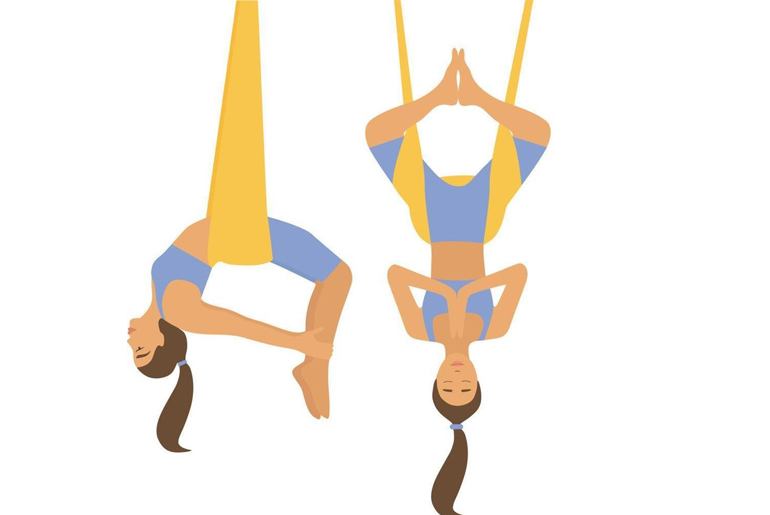Stress is a constant challenge in our fast-paced lives, often stemming from work, tight schedules, or personal issues. While techniques like meditation and journaling can help alleviate stress, aerial yoga offers an engaging and effective alternative for stress relief and improved mental health. This unique practice uses a silky hammock to suspend the body in mid-air, enhancing traditional yoga poses. Aerial yoga not only builds strength and flexibility but also serves as a powerful tool to reduce stress and anxiety. Incorporating easy aerial poses into your routine can provide both physical and mental relaxation, making it a fun and effective way to manage stress.
Aerial yoga:
Aerial yoga, also called anti-gravity yoga, is a unique practice that combines traditional yoga poses with elements of Pilates, dance, and acrobatics using a suspended hammock or silk fabric. This allows practitioners to perform movements and postures that may not be possible on the ground, enhancing flexibility, strength, and balance while reducing strain on the joints.
Aerial yoga help in stress relief:
Yes, aerial yoga is a unique and effective method for stress relief that combines physical activity with a sense of enjoyment. The support of the hammock allows for deeper relaxation and helps release tension in tight muscles that often store stress. Inversions, commonly practiced in aerial yoga, improve blood circulation and calm the nervous system. The gentle swaying and floating sensations create a feeling of weightlessness, which reduces anxiety and promotes a more contemplative state, as supported by a study in the journal Research in Dance Education. The focus needed to maintain balance and complete postures helps divert attention from negative thoughts.
Deep breathing during the practice further promotes calmness and lowers cortisol levels. The sensation of being suspended can also create a feeling of security, contributing to emotional well-being. Additionally, aerial yoga boosts body awareness, offering a better understanding of both physical and mental stress. The fun and exciting aspects of the practice can also stimulate the production of endorphins, natural mood enhancers. Moreover, mastering new positions in aerial yoga can increase confidence, which helps to further reduce stress.
Aerial Yoga for Stress Reduction: Must-Try Poses
Aerial yoga can be an incredibly effective practice for reducing stress, providing a sense of relaxation, and improving flexibility. Below are 10 must-try aerial yoga poses that target tension release and promote relaxation:
1. Supported Savasana (Corpse Pose)
- How to Do It: Sit in the hammock, gently lay back, and let the fabric cradle your body.
- Benefits: The hammock supports your entire body, helping you fully relax. This pose allows you to focus on your breath, reducing stress and calming the nervous system.
- Focus: Relax your arms and legs, close your eyes, and let go of tension, feeling supported and safe.
2. Aerial Child’s Pose
- How to Do It: Kneel in front of the hammock and fold forward, allowing your torso to rest inside the fabric.
- Benefits: The hammock supports your weight, releasing tension in the back, shoulders, and neck.
- Focus: Take deep breaths, feeling the gentle stretch in your lower back and allowing your body to release stress.
3. Aerial Supported Inversions
- How to Do It: With proper instruction, gently invert while the hammock supports your hips.
- Benefits: Inverting allows for a change in perspective, calming the mind and relieving stress. It also promotes spinal decompression and circulation.
- Focus: Ensure comfort and stability, hold the pose for a few breaths, and gently return to an upright position.
4. Aerial Gentle Swings
- How to Do It: Sit comfortably in the hammock and gently sway back and forth.
- Benefits: The rocking motion can help release tension and calm the body and mind.
- Focus: Close your eyes, focus on the rhythmic motion, and let go of stress with each gentle swing.
5. Aerial Hip Openers
- How to Do It: Use the hammock to support you as you move into poses like butterfly or frog.
- Benefits: Deepens the stretch in the hips and releases stored tension in the lower body, helping you feel more grounded.
- Focus: Breathe deeply, allowing the hammock to deepen the stretch and release emotional or physical tension.
6. Aerial Supported Backbends
- How to Do It: With the hammock supporting your back, gently arch backward.
- Benefits: Opens the chest and heart, promotes better posture, and relieves stress stored in the back.
- Focus: Be mindful of your spine and avoid over-extending. The hammock’s support provides a safe, gentle backbend.
7. Aerial Lunge and Twist
- How to Do It: Use the hammock for support as you move into a lunge and twist your torso.
- Benefits: The hammock helps deepen the twist, promoting spinal flexibility and releasing tension in the hips and back.
- Focus: Breathe deeply and allow the twist to release any tension in your torso and lower back.
8. Aerial Seated Meditation
- How to Do It: Sit comfortably in the hammock, allowing it to support your posture.
- Benefits: This pose is ideal for meditation and mindfulness practices. It enhances relaxation and promotes deep, calming breathwork.
- Focus: Practice deep breathing or simply sit in stillness, focusing on the present moment and releasing stress.
9. Aerial Downward-Facing Dog
- How to Do It: Use the hammock to support your feet or hands as you move into the downward-facing dog pose.
- Benefits: Deepens the stretch in the spine, shoulders, and hamstrings, while also helping to calm the mind and reduce stress.
- Focus: Feel the stretch in your back and legs, and take long, steady breaths to release tension.
10. Aerial Kneeling Fetal Pose
- How to Do It: Kneel in front of the hammock, fold forward, and rest your head inside the fabric.
- Benefits: This pose provides deep relaxation and comfort, allowing you to release stress and restore energy.
- Focus: Relax your arms and body, focus on your breathing, and practice mindfulness to enhance emotional balance.
Side Effects of Aerial Yoga
While aerial yoga is an excellent form of exercise that provides numerous benefits, there are some potential side effects to be aware of. These can be minimized by practicing with a trained instructor and listening to your body. Here are the main side effects:
1. Muscle Soreness or Strain
- Cause: Like any new form of exercise, aerial yoga can cause muscle soreness, especially for beginners or those with pre-existing conditions.
- Solution: Start with gentle poses and gradually increase intensity. Stretching and proper warm-ups can help reduce soreness.
2. Dizziness or Vertigo
- Cause: Some people may experience dizziness or vertigo, particularly when performing inversions or poses involving a change in perspective. Individuals with a fear of heights or balance issues might be more susceptible.
- Solution: Always perform inversions slowly and under supervision. If you feel dizzy, return to a stable position and take a break. Discuss any concerns with your instructor before trying inverted poses.
3. Skin Irritation or Chafing
- Cause: The fabric of the hammock can cause irritation or chafing, especially in areas of prolonged contact like the inner thighs, arms, and shoulders.
- Solution: Wear fitted clothing, like leggings and long sleeves, to protect your skin. Consider using anti-chafing creams or oils before class.
4. Nausea or Discomfort
- Cause: People prone to motion sickness or those new to inversion poses may experience nausea or discomfort during or after aerial yoga.
- Solution: Start with less intense poses and avoid inversions if you are prone to motion sickness. Drink water before and after your session, and avoid eating heavy meals right before class.
5. Overstretching or Overexertion
- Cause: Pushing your body too hard or overstretching can lead to strains or injury.
- Solution: Always practice within your comfort level. Use the hammock as a supportive tool, but avoid forcing your body into positions that feel painful.
Tips for Safe Practice
- Work with an Experienced Instructor: Especially as a beginner, always practice under the guidance of a certified aerial yoga instructor who can ensure proper alignment and technique.
- Start Slow: Gradually build your strength and flexibility before attempting advanced poses or inversions.
- Listen to Your Body: Pay attention to any signs of discomfort or pain. If you feel lightheaded, dizzy, or uncomfortable, stop and rest.
By following these precautions and practicing safely, you can enjoy the many benefits of aerial yoga while minimizing potential side effects.
Disclaimer:
The information contained in this article is for educational and informational purposes only and is not intended as a health advice. We would ask you to consult a qualified professional or medical expert to gain additional knowledge before you choose to consume any product or perform any exercise.







